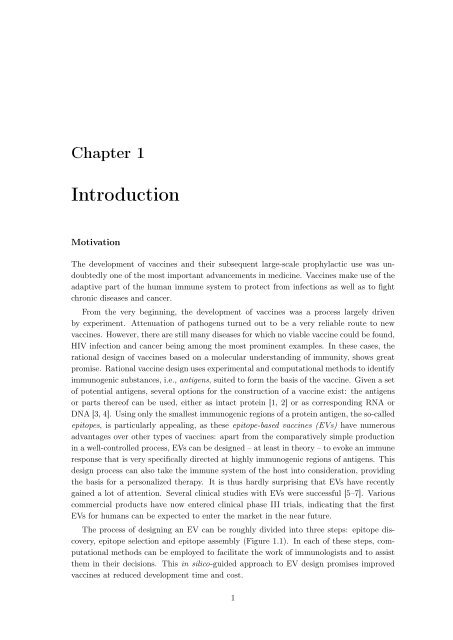New Approaches to in silico Design of Epitope-Based Vaccines
New Approaches to in silico Design of Epitope-Based Vaccines
New Approaches to in silico Design of Epitope-Based Vaccines
Create successful ePaper yourself
Turn your PDF publications into a flip-book with our unique Google optimized e-Paper software.
Chapter 1<br />
Introduction<br />
Motivation<br />
The development <strong>of</strong> vacc<strong>in</strong>es and their subsequent large-scale prophylactic use was undoubtedly<br />
one <strong>of</strong> the most important advancements <strong>in</strong> medic<strong>in</strong>e. Vacc<strong>in</strong>es make use <strong>of</strong> the<br />
adaptive part <strong>of</strong> the human immune system <strong>to</strong> protect from <strong>in</strong>fections as well as <strong>to</strong> fight<br />
chronic diseases and cancer.<br />
From the very beg<strong>in</strong>n<strong>in</strong>g, the development <strong>of</strong> vacc<strong>in</strong>es was a process largely driven<br />
by experiment. Attenuation <strong>of</strong> pathogens turned out <strong>to</strong> be a very reliable route <strong>to</strong> new<br />
vacc<strong>in</strong>es. However, there are still many diseases for which no viable vacc<strong>in</strong>e could be found,<br />
HIV <strong>in</strong>fection and cancer be<strong>in</strong>g among the most prom<strong>in</strong>ent examples. In these cases, the<br />
rational design <strong>of</strong> vacc<strong>in</strong>es based on a molecular understand<strong>in</strong>g <strong>of</strong> immunity, shows great<br />
promise. Rational vacc<strong>in</strong>e design uses experimental and computational methods <strong>to</strong> identify<br />
immunogenic substances, i.e., antigens, suited <strong>to</strong> form the basis <strong>of</strong> the vacc<strong>in</strong>e. Given a set<br />
<strong>of</strong> potential antigens, several options for the construction <strong>of</strong> a vacc<strong>in</strong>e exist: the antigens<br />
or parts there<strong>of</strong> can be used, either as <strong>in</strong>tact prote<strong>in</strong> [1, 2] or as correspond<strong>in</strong>g RNA or<br />
DNA [3, 4]. Us<strong>in</strong>g only the smallest immunogenic regions <strong>of</strong> a prote<strong>in</strong> antigen, the so-called<br />
epi<strong>to</strong>pes, is particularly appeal<strong>in</strong>g, as these epi<strong>to</strong>pe-based vacc<strong>in</strong>es (EVs) have numerous<br />
advantages over other types <strong>of</strong> vacc<strong>in</strong>es: apart from the comparatively simple production<br />
<strong>in</strong> a well-controlled process, EVs can be designed – at least <strong>in</strong> theory – <strong>to</strong> evoke an immune<br />
response that is very specifically directed at highly immunogenic regions <strong>of</strong> antigens. This<br />
design process can also take the immune system <strong>of</strong> the host <strong>in</strong><strong>to</strong> consideration, provid<strong>in</strong>g<br />
the basis for a personalized therapy. It is thus hardly surpris<strong>in</strong>g that EVs have recently<br />
ga<strong>in</strong>ed a lot <strong>of</strong> attention. Several cl<strong>in</strong>ical studies with EVs were successful [5–7]. Various<br />
commercial products have now entered cl<strong>in</strong>ical phase III trials, <strong>in</strong>dicat<strong>in</strong>g that the first<br />
EVs for humans can be expected <strong>to</strong> enter the market <strong>in</strong> the near future.<br />
The process <strong>of</strong> design<strong>in</strong>g an EV can be roughly divided <strong>in</strong><strong>to</strong> three steps: epi<strong>to</strong>pe discovery,<br />
epi<strong>to</strong>pe selection and epi<strong>to</strong>pe assembly (Figure 1.1). In each <strong>of</strong> these steps, computational<br />
methods can be employed <strong>to</strong> facilitate the work <strong>of</strong> immunologists and <strong>to</strong> assist<br />
them <strong>in</strong> their decisions. This <strong>in</strong> <strong>silico</strong>-guided approach <strong>to</strong> EV design promises improved<br />
vacc<strong>in</strong>es at reduced development time and cost.<br />
1

















